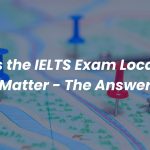IELTS Speaking Band Descriptors are the best way to increase the band scores in the IELTS Speaking Test.
No Matter how many times you read IELTS Speaking topics, nothing comes as fruitful as improving your speaking using IELTS Speaking Band Descriptors.
The SAD PART –
A lot of students remain stuck on a particular band parameter, for example, 5.5 bands, and are unable to improve it to a band 6 because they don’t follow the guidelines properly and keep shooting in the dark. It doesn’t work like this.
The Band Descriptors are designed to help YOU in scoring the required band. They are the map for your progress.
For example, imagine if you have to go to a new place, but have no idea about the way, how would you get there? Google Maps? Isn’t it?
Similarly, the band descriptors help you understand what works in the IELTS Speaking Test and what doesn’t.
Most of the time, students keep working on those things that are useless and are not required in the exam, for example, cramming the fancy vocabulary with their broken English.
Vocabulary aka Lexical Resource is 25% of the IELTS Speaking Test. How can someone decide which words are fancy and which are not?
Speaking Test is a communication exam and not your GRE/GMAT exam which tests your intelligence and aptitude.
Also, read How IELTS Myths stop you from scoring the desired band score in the exam. Break the myths and set yourself free. Click here.
The examiners want to see how clearly you can speak in English and how easily you express yourself.
Expressing is the key!
That is why, a lot of students from rural areas score well, while many from city sides who have schooling from English medium, fail to do so.
IELTS Speaking is divided into 4 parts:
- Fluency & Coherence (25%)
- Lexical Resource (25%)
- Grammar Range & Accuracy (25%)
- Pronunciation (25%)
Over the years, we have seen almost all the students who have given an IELTS test before coming to us that they didn’t know about the IELTS Speaking Band Descriptors.
That is just GROSS on the part of IELTS centres that take money and don’t give valuable coaching in return.
Nonetheless, most students don’t even know the first question topic from IELTS Speaking Part 1 comes from three topics:
- Home
- Home Town
- Work/Study
Voxcel is considered the best IELTS Centre in Ludhiana for such reasons. We take IELTS seriously.
The IELTS trainers have burnt the midnight oil in working on the IELTS teaching skills. They have a mindset to find the problem in students and work on it.
Nonetheless, IELTS Speaking Cue Cards are of 5 types broadly. Many students when they prepare for IELTS Speaking Part 2, cram as many cue cards as possible and even 10 before the exam, they are often seen reading the cue cards from the IELTS Speaking Topics with answers pdf.
Facepalm!
The Five Topics that contain all the cue cards are:
- People
- Place
- Thing
- Event
- Activity
Similarly, Speaking Part 3 also known as Follow Up has seven types of questions that are often asked and most students are unaware of those types.
The seven common question types that appear in IELTS speaking part 3 are:
- Opinion: What is your viewpoint on this? Please explain your reasoning and provide examples.
- Evaluate: What is your assessment of their perspective?
- Future: What do you predict will occur in the future?
- Cause and Effect: What led to this and what consequences has it had?
- Hypothetical: Discuss imaginary or unreal scenarios.
- Compare and Contrast: Discuss the differences and/or similarities between two things.
- Past: How were things different in the past and how have they evolved?
Now you SEE? When you a MAP, you reach YOUR destination SOONER. IELTS Speaking Band Descriptors are that. A MAP!
Who we are? The Light. We act your torch and show you the WAY!
official-ielts-speaking-band-descriptors



